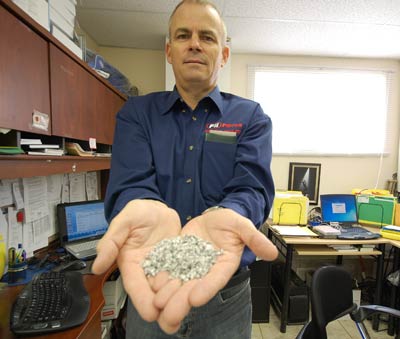 Sudbury-based Fibron Inc.’s Sponge-Jet abrasion blasting technology will help keep the mining industry on the green track.
Sudbury-based Fibron Inc.’s Sponge-Jet abrasion blasting technology will help keep the mining industry on the green track.
Sponge-Jet is a blasting process developed to remove coatings from surfaces. The system recycles and reuses the blasting material, and is designed to reduce waste and hazardous airborne emissions while increasing productivity.“The whole theory behind Sponge-Jet technology is to find a way to reduce worker fatigue, injuries, dust and debris, and to provide something that is more environmentally friendly,” said Brad Shaw,
president and general manager, Fibron Inc.
The company’s products and services also include spray-foam insulation, fireproofing, epoxy lining and coatings, and concrete restoration.
Fibron employs between 10 to 12 people, serving a variety of industries, including mining and pulp and paper. Sponge-Jet blasting and concrete raising, undersealing and soil stabilization are two new services.
Shaw touts the Sponge-Jet blasting system’s cleanliness and increased safety, as well as how thoroughly it cleans a surface. It reduces dust levels as much as 98 per cent – and makes for a much cleaner environment during the blasting process. It also eliminates water, slurry or runoff problems.
The technology uses man-made urethane sponge, called sponge media. Different aggregates are embedded into the sponge, such as aluminum, plastic, steel or even powder in the less aggressive calcium carbonate sponge. The surface being cleaned and the desired finish will determine the type of media used.
“We can sponge blast decorative facades of government buildings without damaging the concrete, or we can do a100-year-old wooden church door,” said Shaw.
Conventional sand-blasting abrasives like copper slag, for example, hits the surface and fractures into multiple pieces with a potential impact speed of 400 kilometres per hour. It has a rebound speed of as much as 375 to 395 km/h, resulting in a hazardous environment and airborne dust.
The sponge used in Sponge-Jet doesn't refract and break like conventional abrasives. Instead, it expands on impact, suppressing air under the sponge when it hits the surface. This creates suction and eventually drops off, eliminating a significant amount of ricochet effect seen with traditional materials.
A hose vacuums up the media, processes it through a classifier, which separates the material through a series of vibrating screens and then reuses it. The system refills continuously while the sponge is being vacuumed. The sponge media can be reused from eight to 18 times, following which a new bag of material is required.
“We reuse the media up to 95 per cent for every process that goes through the unit,” Shaw said.
An LED light at the end of the nozzle allows the workers to see the surface being cleaned, which would otherwise be difficult if inside a dark tank.
Shaw said the product is environmentally approved for incinerators. He also stressed that the job site is left as clean as when they start.
Although the sponge product may be more expensive initially, its environmentally friendly attributes and job performance actually saves money, said Shaw.
He has used Sponge-Jet blasting for several mining companies. Fibron removed paint from brick inside a head frame and off of doorframes. He also removed paint from piping, and resealed and coated the pipes.
Fibron sponge-blasted a bridge for Vale Ltd. in Nairn over an environmentally sensitive area. Because it is recycled and reused, only 3,000 pounds of material was employed, compared with up to 24,000 pounds of material with conventional methods. This reduced the engineering costs for scaffolding, eliminated a vacuum truck to clean debris afterward, and was a safe process for both workers and the environment.
Shaw has the B-Vac high-production system for large industrial jobs like bridges, tanks, rail cars, buildings, and any large structure or vessel. Ultimately, as a distributor, he'd like companies to purchase their own systems, but is more than willing to provide the service on a contracting basis.
He plans to obtain smaller, more portable units and is considering leasing them to interested clients.
The company has also introduced a concrete raising, undersealing and soil stabilization service. Shaw began offering the service about a year ago to help municipalities with ailing infrastructure at 30 to 50
per cent of replacement cost. The process employs high-density polyurethane foam to restore concrete surfaces that have sunk due to frost heaves and/or unstable soil.
It can be used on walkways, roads, concrete abutments, slabs, bridges, sewers, or foundations.
“If you have soil eroding, you can eject (foam) into the soil,” Shaw said. “The product will solidify with the moisture in the soil, and turn it into a 1,600 to 2,000 pounds per square inch (psi) concrete mix. It stops soil erosion and runoff.”
The company can raise slabs from 0.5 inches to six inches, as long as the slab is not broken. Although it is a seasonal service, Shaw sees a huge market for it. This past summer, Fibron worked on 60 sewer manholes in Elliot Lake to avoid replacing them.
“We want to present it to the Ministry of Transportation, municipalities, and/or road contractors that have problems with installed work,” he said. “It is less expensive to them for us to come in and inject it.”
Shaw said the product complements Fibron's other services because a lot of the equipment and expertise is the same.
Currently, the majority of his business is in Parry Sound, North Bay and along the north shore of Lake Huron to Sault Ste. Marie.


